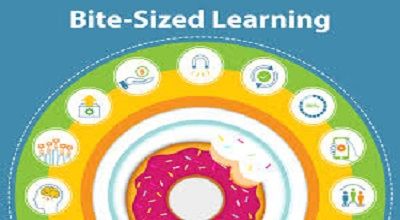Bite-sized Learning (Microlearning)
Bite-sized learning, also known as microlearning, refers to a method of acquiring knowledge or skills through brief, focused learning modules. These modules typically range from a few minutes to half an hour and are designed to deliver specific, actionable information on a particular topic.
Microlearning is often contrasted with traditional learning methods. That involves longer, more comprehensive learning sessions. While traditional learning can be effective for in-depth understanding, microlearning offers several advantages, particularly in today’s fast-paced and information-rich environment.
Benefits of Microlearning
1. Convenience and Accessibility: Microlearning modules can be easily accessed at any time. Anywhere, making it convenient for learners to fit learning into their busy schedules.
2. Focused and Targeted: Each microlearning module focuses on a single concept or skill. Allowing learners to concentrate on specific areas of interest without getting overwhelmed by excessive information.
3. Retention and Recall: The brevity of microlearning modules enhances information retention and recall, as learners can easily revisit and reinforce key points.
4. Engagement and Interactivity: Microlearning often incorporates interactive elements such as quizzes, videos, and simulations, making the learning process more engaging and enjoyable.
5. Adaptability: Microlearning can be tailored to individual learning preferences and needs. Allowing learners to progress at their own pace and choose the topics most relevant to them.
6. Cost-effectiveness: Microlearning can be a cost-effective training and development solution for organizations, as it reduces the need for extensive training sessions and materials.
More Benefits of Bite-sized Learning (Microlearning)
Bite-sized learning, or microlearning, offers several benefits that contribute to its popularity in educational and training settings. Here are some key advantages:
- Increased Engagement: Microlearning content is designed to be short and focused. Which helps maintain learner engagement. Learners are more likely to stay attentive and retain information. When it is presented in small, manageable chunks.
- Time-efficient: Microlearning is time-efficient for both learners and organizations. Employees can acquire new skills or information without dedicating extended periods to training. This efficiency is particularly beneficial in fast-paced work environments.
- Improved Retention: Breaking down information into smaller units helps improve retention. Learners can focus on specific concepts or skills, reinforcing their understanding through repeated, short interactions with the material.
- Adaptability to Learning Styles: Microlearning often incorporates diverse formats such as videos, infographics, quizzes, and interactive elements. This variety caters to different learning styles, ensuring that the content resonates with a broad audience.
- Easy Integration with Technology: Microlearning aligns well with digital platforms and technology. It can leverage multimedia elements, interactive features, and adaptive learning technologies to enhance the overall learning experience.
Read more benefits…
- Continuous Learning Culture: Microlearning encourages a culture of continuous learning. Learners can easily incorporate short learning sessions into their routines, promoting ongoing skill development and knowledge enhancement.
- Spaced Repetition: Microlearning is conducive to spaced repetition, where learners encounter information at intervals over time. This approach helps reinforce learning and improve long-term retention.
- Accessibility and Inclusivity: Microlearning, delivered through digital platforms, enhances accessibility. Learners with diverse needs can access content at their own pace, and the modular nature of microlearning makes it easier to adapt to different learning abilities.
- Quick Updates and Revisions: Microlearning content can be updated or revised more easily than longer, comprehensive courses. This agility allows organizations to keep their training materials current and aligned with evolving industry trends.
- Real-time Application: Since microlearning often focuses on specific tasks or concepts, learners can apply their newly acquired knowledge immediately in real-world situations. This immediate application reinforces the learning process.
Summary
Microlearning is widely adopted in corporate training. Educational institutions and various online learning platforms. Its popularity is driven by the recognition that short, targeted learning experiences are better suited to the modern learner’s preferences and attention spans.
The benefits of bite-sized learning, or microlearning, include increased engagement, flexibility, efficiency, adaptability, and cost-effectiveness. These advantages make it a valuable approach for organizations and educators seeking to meet the learning needs of modern audiences.
